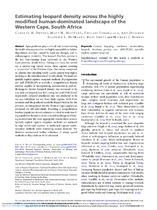| dc.contributor.author | Devens, Carolyn H | |
| dc.contributor.author | Hayward, Matt W | |
| dc.contributor.author | McManus, Jeannine S | |
| dc.date.accessioned | 2022-01-13T10:19:51Z | |
| dc.date.available | 2022-01-13T10:19:51Z | |
| dc.date.issued | 2021 | |
| dc.identifier.citation | Devens, C. H. et al. (2021). Estimating leopard density across the highly modified human-dominated landscape of the Western Cape, South Africa. ORYX, 55(1), 34-45 | en_US |
| dc.identifier.issn | 1365-3008 | |
| dc.identifier.uri | 10.1017/S0030605318001473 | |
| dc.identifier.uri | http://hdl.handle.net/10566/7088 | |
| dc.description.abstract | Apex predators play a critical role in maintaining
the health of ecosystems but are highly susceptible to habitat
degradation and loss caused by land-use changes, and to
anthropogenic mortality. The leopard Panthera pardus is
the last free-roaming large carnivore in the Western
Cape province, South Africa. During –, we carried
out a camera-trap survey across three regions covering
c. , km of the Western Cape. Our survey comprised
camera sites sampling nearly , camera-trap nights,
resulting in the identification of individuals. We used two
spatially explicit capture–recapture methods (R programmes
secr and SPACECAP) to provide a comprehensive density
analysis capable of incorporating environmental and anthropogenic factors. | en_US |
| dc.language.iso | en | en_US |
| dc.publisher | Cambridge University | en_US |
| dc.subject | Camera trapping | en_US |
| dc.subject | Carnivore conservation | en_US |
| dc.subject | Leopard | en_US |
| dc.subject | Western Cape | en_US |
| dc.subject | Apex predators | en_US |
| dc.title | Estimating leopard density across the highly modified human-dominated landscape of the Western Cape, South Africa | en_US |
| dc.type | Article | en_US |

